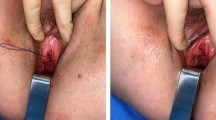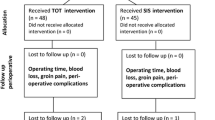Abstract
Introduction and hypothesis
To determine the clinical outcomes of adding a tension-releasing suture (TRS) appendage for manipulation of over-tensioned single-incision slings (SIS) as a means to relieve postoperative voiding dysfunction.
Methods
A retrospective observational study conducted from January 2010 to July 2017. The records of patients with urodynamic stress incontinence (USI) without needing concurrent procedures who underwent anti-incontinence surgery using MiniArc, Solyx, and Ajust with voiding dysfunction were collated and analyzed. The primary outcome measure was the recovery of normal post-void residual urine (PVR) after TRS manipulation. The secondary outcome measures were the pain intensity noted during manipulation (quantified by visual analog scale) and the continence rate [assessed by (1) objective cure: 1-h pad test weight < 2 g and absence of USI; (2) subjective cure index score ≤ 1 on question 3 of the UDI-6: “Urine leakage related to physical activity, coughing, or sneezing?”].
Results
There were 73 patients with high post-void residual (PVR) urine. The 42 (9.5%) patients with over-tensioned slings were managed with TRS manipulation while the 31 patients (7%) with high PVR and no sling over-tension were managed with intermittent catheterization. All patients in both groups regained normal PVR. The TRS-manipulated group demonstrated an objective cure rate of 92.9% (39/42) and subjective cure rate of 91% (38/42). Pain experienced during TRS manipulation was significantly higher with the Ajust system (p = 0.018). Three patients had persistence of USI, two with MiniArc and one with Solyx.
Conclusions
The TRS manipulation is a well-tolerated procedure that can effectively relieve voiding dysfunction for over-tensioned SIS without affecting continence cure rates.



Similar content being viewed by others
References
Dmochowski RR, Blaivas JM, Gormley EA, Juma S, Karram DJ, Lightner DJ, et al. Update of AUA guideline on the surgical management of female stress urinary incontinence. J Urol. 2010;183:1906–14.
Karram MM, Segal JL, Vassallo BJ, Kleeman SD. Complications and untoward effects of the tension-free vaginal tape procedure. Obstet Gynecol. 2003;10(5):929–32.
Haylen BT, de Ridder D, Freeman RM, et al. An International Urogynecological Association (IUGA)/International Continence Society (ICS) joint report on the terminology for female pelvic floor dysfunction. Neurourol Urodyn. 2010;29:4–20.
Dawson T, Lawton V, Adams E, Richmond D. Factors predictive for post-TVT voiding dysfunction. Int Urogynecol J Pelvic Floor Dysfunct. 2007;18(11):1297–302.
Rosenblum N, Nitti VW. Post-urethral suspension obstruction. Curr Opin Urol. 2001;11(4):411–6.
Shoebeiri SA, Nihira MA. Attachment of a sling rescue suture to mid-urethral tape for management of potential postoperative voiding dysfunction. Neurourol Urodyn. 2009;28:990–4.
Lo TS, Pue BL, Tan YL, et al. Tension-releasing suture appendage on single-incision sling device: a novel approach to postoperative voiding dysfunction. Taiwan J Obstet Gynecol. 2016;55:519–24.
Haylen BT, Freeman RM, Swift SE, Cosson M, Davila GW, Deprest J, et al. An International Urogynecological Association (IUGA)/International Continence Society (ICS) joint terminology and classification of the complications related directly to the insertion of prostheses (meshes, implants, tapes) & grafts in female pelvic floor surgery. Int Urogynecol J. 2011;22:3–15.
Lose G. Urethral pressure measurement. Acta Obstet Gynecol Scand Suppl. 1997;166:39–42.
Blaivas J, Groutz A. Bladder outlet obstruction nomogram for women with lower urinary tract symptomatology. Neurourol Urodyn. 2000;19:553e64.
Jeong SJ, Kim HJ, Lee YJ, et al. Prevalence and clinical features of detrusor underactivity among elderly with lower urinary tract symptoms: a comparison between men and women. Korean J Urol. 2012;53:342–8.
Hawker GA, Mian S, Kendzerska T, French M. Measures of adult pain: visual analog scale for pain (VAS), numeric rating scale for pain (NRS pain), McGill pain questionnaire (MPQ), short-form McGill pain questionnaire (SF-MPQ), chronic pain grade scale (CPGS), short form- 36 bodily pain scale (SF). Arthritis Care Res. 2011;63:240–52.
Moore RD, Mitchell GK, Miklos JR. Single-center retrospective study of the technique safety and 12-month efficacy of the MiniArc single-incision sling: a new minimally invasive procedure for the treatment of female SUI. Surg Technol Int. 2009;18:175–81.
Serels S, Nosseir SB, Lind LR, Winkler HA. Safety and efficacy of the Solyx single-incision sling for the treatment of stress urinary incontinence: preliminary results. UroToday Int J. 2011;4:art5.
Abdel-Fattah M, Agur W, Abdel-All M, et al. Prospective multi-Centre study of adjustable single-incision mini-sling Ajust in the management of stress urinary incontinence in women: 1-year follow-up study. BJU Int. 2012;109:880–6.
Lo TS, Wang AC, Horng SG, Liang CC, Soong YK. Ultrasonographic and urodynamic evaluation after tension free vaginal tape procedure (TVT). Acta Obstet Gynecol Scand. 2001;80:65–70.
Palma P, Siniscalchi RT, Maciel LC, et al. Primary fixation of mini-slings: a comparative biomechanical study in vivo. Int Braz J Urol. 2012;38:258–65.
Alinsod R. Recent advances in tape slings for female urinary stress incontinence. Rev Obstet Gynecol. 2009;2:46–50.
Lenz F, Doll S, Sohn C, Brocker K. Single-incision mini-slings: obturator complex pull-out-force measurements. Gynecol Obstet Investig. 2017;82:376–81.
Greenberg J, Clark R. Advances in suture material for obstetrics and gynecologic surgery. Rev Obstet Gynecol. 2009;2:146–58.
Speakman MJ, Brading AF, Guilpin CJ, et al. Bladder outflow obstruction: a cause of denervation supersensitivity. J Urol. 1987;138:1461–6.
Author information
Authors and Affiliations
Corresponding author
Ethics declarations
Conflict of interest
None.
Rights and permissions
About this article
Cite this article
Lo, TS., Chua, S., Tseng, LH. et al. Clinical outcomes on tension-releasing suture appendage on single-incision sling devices for postoperative voiding dysfunction involving undue tape tension. Int Urogynecol J 30, 1509–1517 (2019). https://doi.org/10.1007/s00192-018-3826-9
Received:
Accepted:
Published:
Issue Date:
DOI: https://doi.org/10.1007/s00192-018-3826-9




